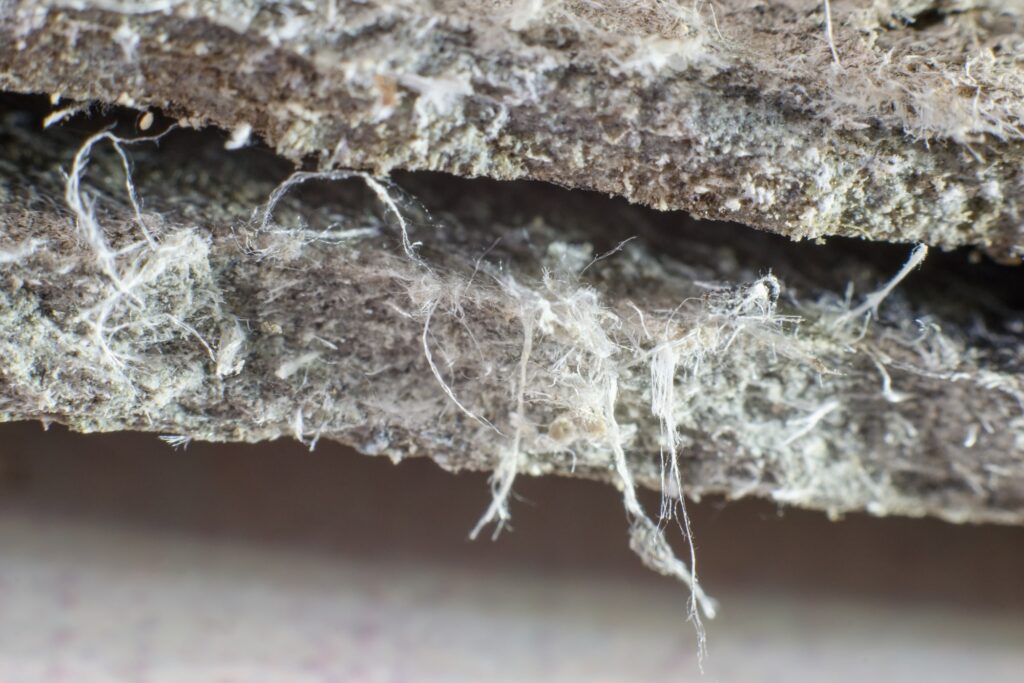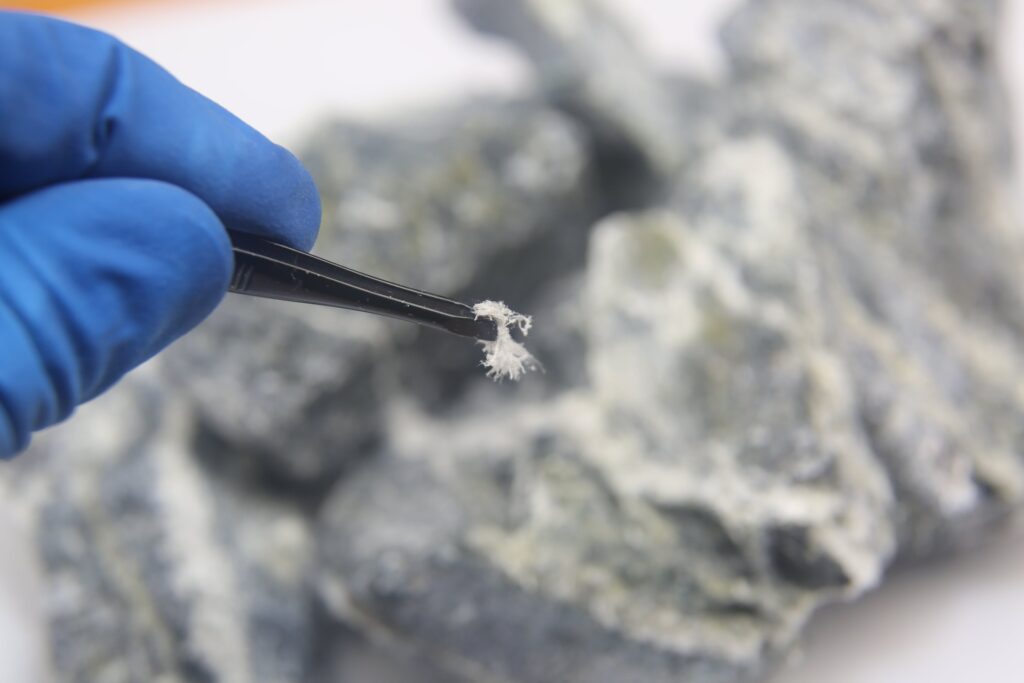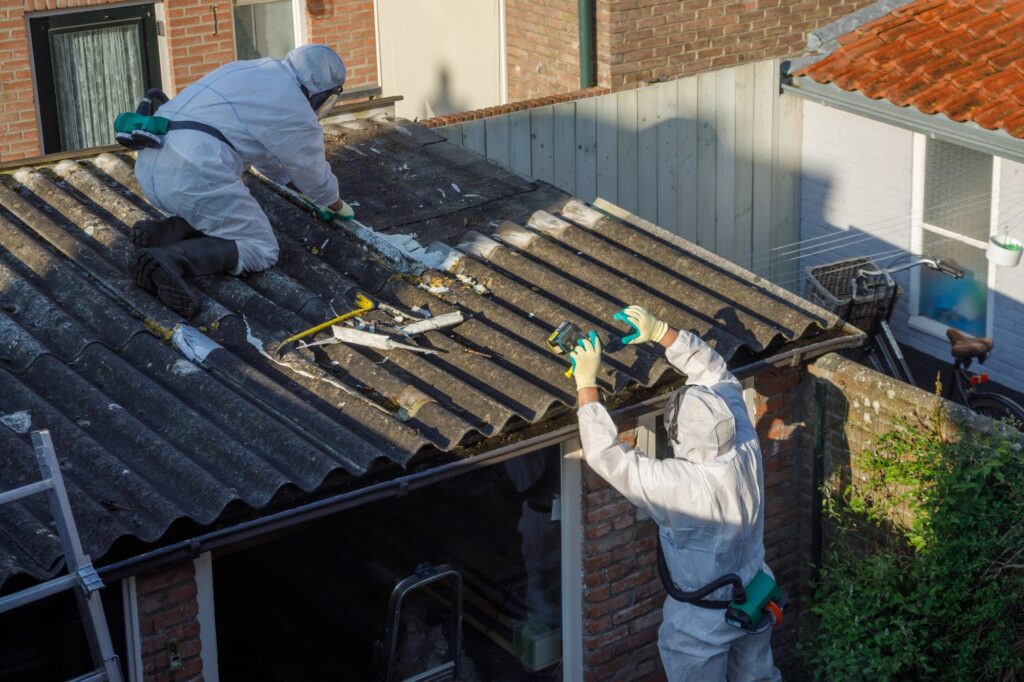If you’re a homeowner, it’s important to know what asbestos looks like, particularly if you have an older home where asbestos can be found in a variety of materials. Asbestos is a naturally occurring mineral that was widely used in building materials until the 1980s due to its insulating and fire-resistant properties, making it common to find asbestos in the home, particularly in older houses. However, it’s now known to be a serious health hazard when its fibers become airborne and are inhaled.
Asbestos fibers can be released into the air when materials containing asbestos are disturbed, such as during renovations or demolition. If you suspect that your home may contain asbestos, it’s crucial to take proper precautions to avoid asbestos exposure. This includes not disturbing any suspected asbestos-containing materials and hiring a professional to test and, if necessary, remove the materials safely.
Knowing what asbestos looks like can help you identify potential hazards in your home. Asbestos can come in many forms, including insulation, roofing materials, flooring, and even some types of textured paint. It’s important to be aware of the materials that are likely to contain asbestos and to take appropriate measures to protect yourself and your family from exposure.
Identifying Asbestos: Type of Asbestos Materials (What Does Asbestos Look Like?)

Identifying asbestos in various materials is crucial to avoid potential health hazards. Asbestos was commonly used in building materials until the 1980s, so it’s essential to know what to look for if you’re renovating or demolishing an older building. In this section, we’ll discuss how to identify asbestos in different materials.
Asbestos Thermal Insulation
Asbestos insulation was commonly used in homes and commercial buildings to insulate pipes, boilers, and ductwork. It was also used in thermal products like furnace ducts, stove-top pads, and oven mitts. Asbestos insulation can be identified by its fibrous, fluffy texture and gray or white color. It may also be wrapped in a cloth-like material, commonly found in thermal insulation components in older homes.
Asbestos Floor Tiles and Asbestos Vinyl Products
Asbestos was used in vinyl products and floor tiles until the 1980s. Asbestos-containing floor tiles are usually nine inches by nine inches and may have a pattern or texture. They are usually black, white, or a combination of both. Asbestos vinyl products may be found in sheet form and were commonly used as backing for linoleum and vinyl flooring.
Asbestos Cement Product and Siding
Asbestos was used in cement products and siding until the 1980s. Asbestos cement products may be found in roofing shingles, corrugated roofing, and pipes. Asbestos siding was commonly used in homes and commercial buildings and may be identified by its corrugated texture and gray or white color.
Asbestos Textiles and Asbestos Paper
Asbestos was used in textiles and papers until the 1980s. Asbestos textiles were commonly used in insulation blankets, fireproof clothing, and theater curtains. Asbestos paper was used as insulation in electrical equipment and as a backing for wall coverings. Asbestos textiles and papers can be identified by their fibrous texture and gray or white color.
It’s important to note that not all materials containing asbestos are easy to identify. Asbestos may be found in a variety of materials, including but not limited to, ceiling tiles, plaster, and drywall. If you suspect a material may contain asbestos, it’s best to have it tested by a professional.
Remember, if you’re renovating or demolishing an older building, it’s crucial to take the necessary precautions to avoid potential health hazards. By knowing how to identify asbestos in various materials, you can ensure the safety of yourself and those around you.
Health Risks and Safety Measures
Understanding Exposure to Asbestos
Asbestos is a hazardous material that can cause serious health problems if inhaled or ingested. Exposure to asbestos can lead to various diseases, including lung cancer, mesothelioma, and asbestosis. If you’ve been exposed to asbestos, it’s important to understand the health risks and take necessary safety measures to prevent further exposure.
Asbestos fibers are released into the air when asbestos-containing materials are disturbed or damaged. These fibers can easily get into your lungs and stay there for a long time, causing damage over time. Asbestos can be hazardous even in small amounts, so it’s crucial to take precautions when handling asbestos-containing materials.
Safe Handling and Prevention of Asbestos Contamination
To prevent exposure to asbestos, it’s important to follow safe handling and removal procedures. If you suspect that a material contains asbestos, do not attempt to handle or remove it yourself. Instead, contact a professional asbestos abatement contractor who is trained and licensed to handle asbestos-containing materials.
When working with asbestos-containing materials, it’s important to wear protective gear, such as a respirator, gloves, and coveralls. You should also make sure to wet the material down before handling it to prevent the release of asbestos fibers. Any asbestos-containing materials should be properly disposed of by local regulations.
It’s also important to be aware of the risks of secondary exposure to asbestos. If you work with asbestos, you may inadvertently bring home asbestos fibers on your clothing, which can put your family members at risk of exposure. To prevent this, make sure to change your clothes and shower before leaving work.
In conclusion, asbestos can be a serious health hazard if not handled properly. By understanding the risks of asbestos exposure and following safe handling procedures, you can protect yourself and others from the harmful effects of asbestos, especially if you decide to remove asbestos from your home.
Detection and Assessment of Asbestos (How to Identify Asbestos)

If you suspect that your home or workplace may contain asbestos, it is important to confirm the presence of this hazardous material by conducting a test for asbestos. Detection and assessment of asbestos can be done through professional asbestos testing or DIY asbestos testing kits.
Professional Asbestos Testing
Licensed asbestos professionals can perform asbestos testing and provide a comprehensive report of their findings. These professionals use specialized equipment and techniques to collect samples of suspected materials and analyze them in a laboratory setting. The report will indicate whether or not asbestos is present and the extent of the contamination.
DIY Asbestos Testing Kits
Asbestos testing kits are available for purchase and can be used to collect samples of suspected materials. These kits typically include instructions for collecting the sample, a sample bag, and a prepaid envelope for mailing the sample to a laboratory. It is important to follow the instructions carefully and to use proper protective equipment when collecting the sample.
It is important to note that DIY asbestos testing kits may not be as accurate as professional testing. Additionally, handling and collecting asbestos samples can be dangerous and may pose health risks. It is recommended to hire a licensed asbestos professional for accurate and safe testing.
If asbestos is present, it is crucial to take appropriate measures to ensure the safety of those in the affected area. Licensed asbestos professionals can guide the proper steps to take for asbestos removal and disposal.
In summary, confirming the presence of asbestos is crucial for ensuring the safety of those in the affected area. Professional asbestos testing and DIY asbestos testing kits are available options for detection and assessment. However, it is recommended to hire a licensed asbestos professional for accurate and safe testing.
Legal and Regulatory Considerations
Asbestos Laws and Regulations
When it comes to asbestos, there are several laws and regulations in place to protect individuals from its harmful effects. These laws and regulations are designed to ensure that asbestos is handled and disposed of safely and that individuals who work with or around asbestos are properly trained and protected.
Some of the most important asbestos laws and regulations include the Asbestos Hazard Emergency Response Act (AHERA), the Clean Air Act (CAA), and the Occupational Safety and Health Administration (OSHA) asbestos standards. AHERA requires all schools to be inspected for asbestos, and if asbestos is found, to have a plan in place to manage it. The CAA regulates the release of asbestos fibers into the air, and OSHA sets standards for workers who may be exposed to asbestos on the job.
Certified Asbestos Abatement
If you are involved in a project that involves asbestos, it is important to hire a licensed and certified asbestos abatement professional. These professionals are trained to safely remove and dispose of asbestos-containing materials and are required to follow strict guidelines and regulations.
Removal and Disposal

Professional Asbestos Removal
If you suspect that your home or building may contain asbestos, it is strongly recommended that you hire a professional asbestos removal company to remove it. Asbestos can be extremely dangerous when disturbed, and improper removal can result in asbestos contamination of your home or building. Professional asbestos removal companies have the expertise and equipment necessary to safely remove asbestos-containing materials and dispose of them properly, ensuring your older home is safe.
When hiring a professional asbestos removal company, be sure to choose a licensed and insured company with experience in asbestos abatement. The company should provide you with a detailed plan for the removal of the asbestos-containing materials, including all necessary safety precautions and procedures. The company should also provide you with a written contract outlining the scope of work, timeline, and cost of the project.
Do-It-Yourself Precautions (Be Careful of Asbestos Exposure!)
If you choose to remove asbestos-containing materials yourself, it is important to take all necessary precautions to protect yourself and others from exposure to asbestos. Asbestos fibers can become airborne when asbestos-containing materials are disturbed, and inhalation of these fibers can cause serious health problems.
Before beginning any asbestos removal project, it is important to test the materials to confirm the presence of asbestos. If asbestos is present, you should wear appropriate personal protective equipment, including a respirator, gloves, and disposable coveralls. You should also wet the materials with a fine mist of water to prevent the release of asbestos fibers.
When removing asbestos-containing materials, it is important to work carefully and avoid breaking or damaging the materials. Asbestos-containing materials should be placed in leak-tight containers and labeled as asbestos waste to ensure safe handling and proper disposal of the asbestos material. Asbestos waste should be disposed of at a landfill that is authorized to accept asbestos waste.
Remember, the removal of asbestos is a serious matter and should not be taken lightly. Whether you choose to hire a professional asbestos removal company or do it yourself, it is crucial to take all necessary precautions to protect yourself and others from exposure to asbestos fibers.
Conclusion
Now that you know what asbestos looks like, you can take steps to protect yourself and your loved ones from exposure. Remember that asbestos was widely used in construction materials until the 1970s, so it’s important to be cautious when renovating or repairing older buildings.
If you suspect that a material may contain asbestos, do not attempt to remove or disturb it yourself. Instead, contact a licensed asbestos professional who can safely test and remove the material if necessary.
In addition to being aware of the appearance of asbestos, it’s also important to understand the health risks associated with exposure. Asbestos exposure can lead to serious lung diseases and cancers, so it’s crucial to take precautions to avoid exposure whenever possible.
Staying informed about the dangers of asbestos and taking steps to protect yourself can help prevent the negative health effects associated with this dangerous substance.
